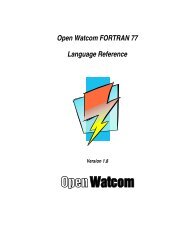Relocatable Object Module Format (OMF) Specification
Relocatable Object Module Format (OMF) Specification
Relocatable Object Module Format (OMF) Specification
Create successful ePaper yourself
Turn your PDF publications into a flip-book with our unique Google optimized e-Paper software.
<strong>Relocatable</strong> <strong>Object</strong> <strong>Module</strong> <strong>Format</strong><br />
7EH DEBSYM Debug Symbols Record<br />
This record provides information about all local symbols, including stack and<br />
based symbols. The purpose of this information is to aid debugging programs.<br />
84H PEDATA Physical Enumerated Data Record<br />
This record provides contiguous data, from which a portion of an 8086 memory<br />
image may be constructed. The data belongs to the "unnamed absolute<br />
segment" in that it has been assigned absolute 8086 memory addresses and<br />
has been divorced from all logical segment information.<br />
86H PIDATA Physical Iterated Data Record<br />
This record provides contiguous data, from which a portion of an 8086 memory<br />
image may be constructed. It allows initialization of data segments and provides<br />
a mechanism to reduce the size of object modules when there is repeated data<br />
to be used to initialize a memory image. The data belongs to the "unnamed<br />
absolute segment."<br />
8EH TYPDEF This record contains details about the type of data represented by a name<br />
declared in a PUBDEF or EXTDEF record. For more details on this record, refer<br />
to its description later in this appendix.<br />
92H LOCSYM Local Symbols Record<br />
This record provides information about symbols that were used in the source<br />
program input to the translator that produced the module. This information is<br />
used to aid debugging programs. This record has a format identical to the<br />
PUBDEF record.<br />
9EH (none) Unnamed record<br />
This record number was the only even number not defined by the original Intel<br />
8086 specification. Apparently it was never used.<br />
A4H LIBHED Library Header Record<br />
This record is the first record in a library file. It immediately precedes the<br />
modules (if any) in the library. Following the modules are three more records in<br />
the following order: LIBNAM, LIBLOC, and LIBDIC.<br />
A6H LIBNAM Library <strong>Module</strong> Names Record<br />
This record lists the names of all the modules in the library. The names are<br />
listed in the same sequence as the modules appear in the library.<br />
A8H LIBLOC Library <strong>Module</strong> Locations Record<br />
This record provides the relative location, within the library file, of the first byte of<br />
the first record (either a THEADR or LHEADR or RHEADR record) of each<br />
module in the library. The order of the locations corresponds to the order of the<br />
modules in the library.<br />
AAH LIBDIC Library Dictionary Record<br />
This record gives all the names of public symbols within the library. The public<br />
names are separated into groups; all names in the nth group are defined in the<br />
nth module of the library.<br />
Tool Interface Standards (TIS) <strong>OMF</strong> <strong>Specification</strong>, Version 1.1 77
















